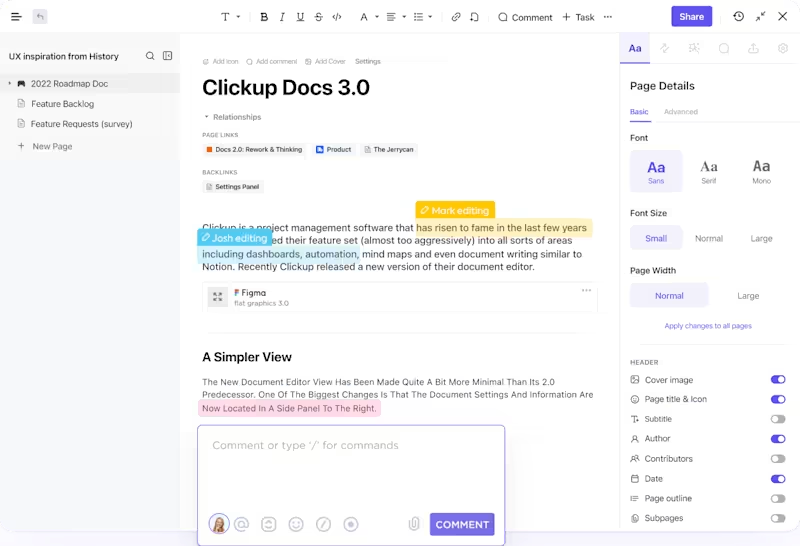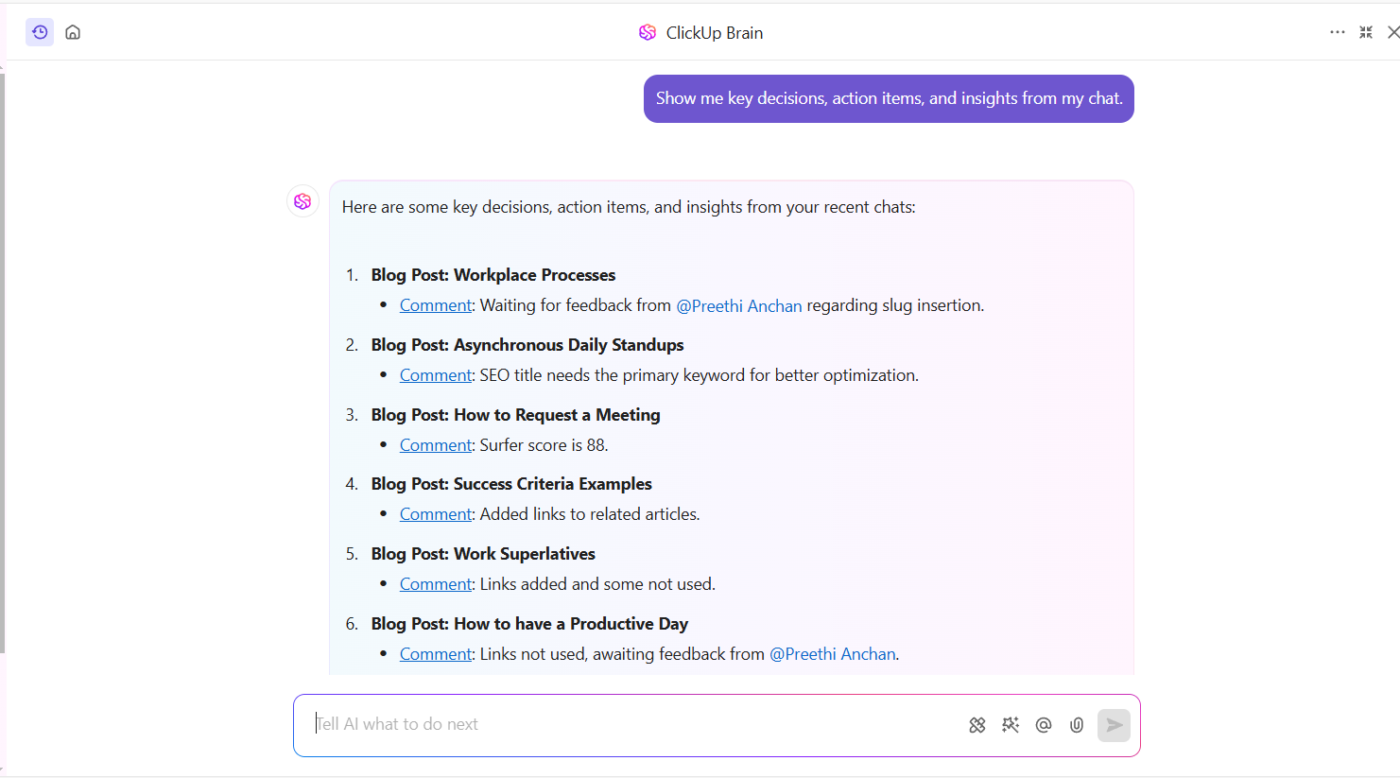Meeting Goals: Strategies for Effective Leadership

Sorry, there were no results found for “”
Sorry, there were no results found for “”
Sorry, there were no results found for “”
You’ve probably sat through a meeting that felt like a black hole—endless discussions, no clear direction, and nothing concrete to show for it.
Now, imagine a meeting where every minute counts, decisions are made, and everyone leaves knowing exactly what to do next. The difference? Clear meeting goals.
Meetings are the crux of corporate communication and a well-balanced workflow. Without solid goals they can become anti-productive and just another excess time-consuming task.
🌎 Fact Check: Almost 71% of professionals find meetings unproductive and inefficient, often due to a lack of clear objectives!
Meetings without a defined purpose often lead to confusion, delays, and wasted time. Without clear goals, many meetings become repetitive, draining productivity instead of driving results. Setting structured meeting goals ensures discussions stay focused and lead to more productive meetings with measurable outcomes.
When goals are set in advance, teams can:
Whether it’s problem-solving, reviewing progress, or brainstorming innovative ideas, setting meeting goals ensures every conversation moves in the right direction. It also encourages constructive feedback, so teams leave each meeting with clarity, accountability, and the momentum to execute.
💥 Bonus Content: Looking for a way to ensure you never miss a single point, action item, or word from meetings? Try ClickUp AI Notetaker!
Use it to automatically create meeting notes, generate searchable meeting transcripts and perfect summaries, identify action items, and connect all of this to your work in ClickUp!
A well-planned meeting can drive decisions, strengthen collaboration, and boost efficiency. Without clear goals, however, meetings often lead to more meetings and with little to show for it.
Defining meeting goals helps teams:
Meetings should create momentum, not stall progress. Setting SMART goals ensures discussions stay focused, efficient, and action-driven. This helps teams achieve real outcomes instead of just talking about them.
When every meeting has a specific purpose, measurable objectives, and actionable outcomes, teams can stay on track, make faster decisions, and avoid unnecessary follow-ups.
To ensure meetings are productive and action-driven, follow these structured steps to set effective meeting goals that drive real outcomes.
Read More: How to Run Effective Meetings?
Here’s a step-by-step guide to setting effective meeting goals that turn discussions into results.
Meetings without a clear purpose often spiral into unnecessary discussions. Before scheduling a meeting, ask:
Defining a specific objective ensures discussions remain intentional and structured, preventing meetings from becoming routine status updates.
📌 Use ClickUp Goals to document and align meeting objectives with broader business priorities, so every session has a clear reason to exist.
A meeting goal should define what needs to be achieved and how success will be measured. Without clear goals, meetings often spiral into lengthy conversations with no actionable takeaways.
Using the SMART framework ensures meeting goals are:
🔹 Example: Instead of “discuss the sales strategy”, set a goal like “Select three target industries for the Q2 sales campaign, finalize the outreach strategy for each, and assign owners for execution by the end of the meeting.”
📌 Use the ClickUp SMART Goals Template to structure meeting goals and ensure discussions stay goal-oriented and actionable.
This template helps teams:
A meeting goal should always serve a bigger purpose. If it doesn’t contribute to ongoing projects, business objectives, or key results, it’s just another distraction. Setting goals that align with priorities ensures meetings lead to decisions, not just discussions.
Meetings should move work forward. If a meeting doesn’t support decision-making, project milestones, or team performance, it’s a time drain. Every goal should be linked to a tangible outcome.
Meetings that don’t contribute to these areas often result in unnecessary follow-ups.
Even with a solid goal, a meeting can still disrupt progress if it competes with urgent priorities. Before setting a meeting goal, check.
A well-timed meeting speeds up execution, while a poorly planned one creates unnecessary follow-ups.
Meetings fall apart when attendees don’t know their roles. Set clear expectations beforehand so every participant is prepared and engaged.
Want to perfect your approach to asynchronous collaborations? Check out this video: 👇
When meeting goals align with business priorities and team workloads, they become high-impact working sessions and not just calendar fillers.
💡Pro Tip: Try ClickUp Meetings to smoothly manage all your meeting tasks
A well-run meeting ends with decisions and next steps.
To ensure this happens:
🔹 Example: Instead of “brainstorm ideas for a marketing campaign”, set a goal like “Select the top three campaign ideas and assign owners for execution.”
📌 Use the ClickUp Meeting Agenda Template to structure discussions so every meeting has clear takeaways and next steps.
With this template, you can:
A meeting’s impact isn’t measured by how engaging it was rather it’s measured by what happens afterward.
Teams should:
Without a system for tracking follow-ups, meetings often result in repeated conversations rather than actual execution.
Setting effective meeting goals ensures that team meetings stay focused, actionable, and results-driven. When meetings are structured with clear objectives, they become powerful tools for decision-making and strategic execution—not just another item on the calendar.
Not all meetings serve the same purpose. Some focus on decision-making, others on problem-solving, and some track progress and alignment. Whatever the meeting type, a well-defined goal ensures conversations lead to concrete action rather than another follow-up meeting.
These meetings exist to make a choice, finalize a plan, or approve an action. A vague goal like “Discuss marketing budget” leads to endless debates. Instead, define an objective that forces a decision.
✅ Goal: Allocate the marketing budget for Q2 based on projected ROI
🔹 Specific Target: Compare three campaign proposals, approve funding for the top two, and assign spending limits for each
📌 Success Indicator: By the end of the meeting, the budget is finalized and approved, and finance has clear spending guidelines
✅ Goal: Approve the final launch timeline and marketing assets
🔹 Specific Target: Evaluate creative materials, confirm rollout strategy, and greenlight distribution plan
📌 Success Indicator: The launch date is locked, and all teams know their next steps
These meetings should resolve a bottleneck, troubleshoot an issue, or optimize a process. Without a structured goal, they easily turn into complaint sessions.
✅ Goal: Reduce resolution time for Tier 1 support tickets
🔹 Specific Target: Identify the top three delay points in current workflows and implement process changes to cut resolution time by 30%
📌 Success Indicator: A new workflow is drafted, and team leads assign implementation steps
👀Did You Know? The world’s oldest recorded customer complaint dates back to 1750 BC
A merchant named Nanni wrote a furious message on a clay tablet, calling out his supplier, Ea-nāṣir, for delivering poor-quality copper.
Even in ancient times, poor support led to escalations—proving that fast, effective resolution has always been key to customer satisfaction.
✅ Goal: Resolve delays in product shipments due to inventory misalignment
🔹 Specific Target: Pinpoint the cause of recurring delays and adjust supplier contracts or warehouse stocking processes
📌 Success Indicator: A new supply chain strategy is finalized, with short-term fixes implemented immediately
These meetings ensure work stays on track and that teams are aligned with business goals. Instead of vague check-ins, they should measure specific progress.
✅ Goal: Assess completion of sprint objectives and prioritize next backlog items
🔹 Specific Target: Review completed tasks, analyze blockers, and reassign priorities for the next development cycle
📌 Success Indicator: The next sprint plan is locked, and engineers have assigned development tasks
✅ Goal: Evaluate Q1 sales numbers and adjust regional targets for Q2
🔹 Specific Target: Compare revenue vs. projections, reallocate resources to high-performing regions, and set new targets for underperforming areas
📌 Success Indicator: Sales teams receive updated targets with a clear strategy for execution
These meetings set long-term direction, and without structured goals, they can spiral into aimless brainstorming.
✅ Goal: Define company-wide objectives and priorities for the upcoming year
🔹 Specific Target: Set five company-wide strategic priorities, align department goals, and determine key performance metrics
📌 Success Indicator: Leadership signs off on the roadmap, and department heads begin breaking down execution plans
✅ Goal: Evaluate new market opportunities and decide on expansion focus
🔹 Specific Target: Compare three potential regions for expansion, analyze risk factors, and choose the most viable location for launch
📌 Success Indicator: A geographic expansion strategy is confirmed, and teams begin market research
Meetings should drive action, not just conversation. Whether it’s making a decision, solving a problem, or aligning on progress, a strong meeting goal ensures every session leads to a measurable outcome.
Different meeting formats require different strategies to keep meeting goals actionable. Virtual meetings need structure, while asynchronous collaboration minimizes unnecessary calls and ensures progress without disrupting workflows.
Without a structured approach, virtual meetings can quickly lose focus. To keep discussions productive:
Not all discussions need to happen in real time. Asynchronous collaboration allows teams to:

📌 ClickUp Docs and ClickUp Tasks provide a structured way to share agendas, take notes, assign tasks, and track decisions. These tools ensure every meeting leads to real outcomes.
Thus by combining structured virtual meetings with effective asynchronous collaboration, teams can stay aligned, minimize wasted time, and drive meeting goals forward efficiently.
A well-structured meeting sets things in motion, but what happens afterward determines its success. If goals aren’t followed through, meetings become routine discussions instead of decision-making tools.
The key is to refine how teams execute meeting outcomes and ensure every session leads to measurable progress.
Short-term action items should always align with business priorities. Meetings that focus on isolated tasks without considering the bigger picture often waste time.
If you want to ensure that your critical information doesn’t get lost in endless threads, Try using ClickUp Brain. It helps teams make smarter decisions by instantly retrieving key discussions, action items, and historical meeting insights.

Meetings often start with a clear agenda but drift into off-topic discussions. This leads to unclear next steps, follow-up meetings, and misalignment.
Common reasons for goal drift:
To keep meetings goal-oriented:
When meetings stay focused, teams avoid unnecessary follow-ups and wasted time.
Also Read: How to Use AI for Meeting Notes?
Meetings should drive momentum, not create more meetings. If the same topics keep resurfacing, it’s a sign that discussions aren’t translating into action.
A goal-oriented meeting culture isn’t about having more structured discussions—it’s about ensuring that meetings become a direct pipeline to execution.
Meetings should do more than fill calendars. Thus, when teams track meeting goals, prevent unnecessary discussions, and prioritize execution, they transform working session meetings into strategic tools for business growth instead of time-consuming rituals.
Meetings should lead to progress, not delays. Clear objectives and measurable goals keep meetings focused. When every meeting has a purpose, teams can stay on the same page, make faster decisions, and avoid unnecessary follow-ups.
High-performing teams turn conversations into action. Aligning meeting goals with business objectives ensures time is spent on what truly matters. Structured follow-ups keep projects on track and eliminate confusion. Therefore, the right system makes all the difference.
Start running productive meetings that drive real impact. Sign up for ClickUp today!
© 2025 ClickUp